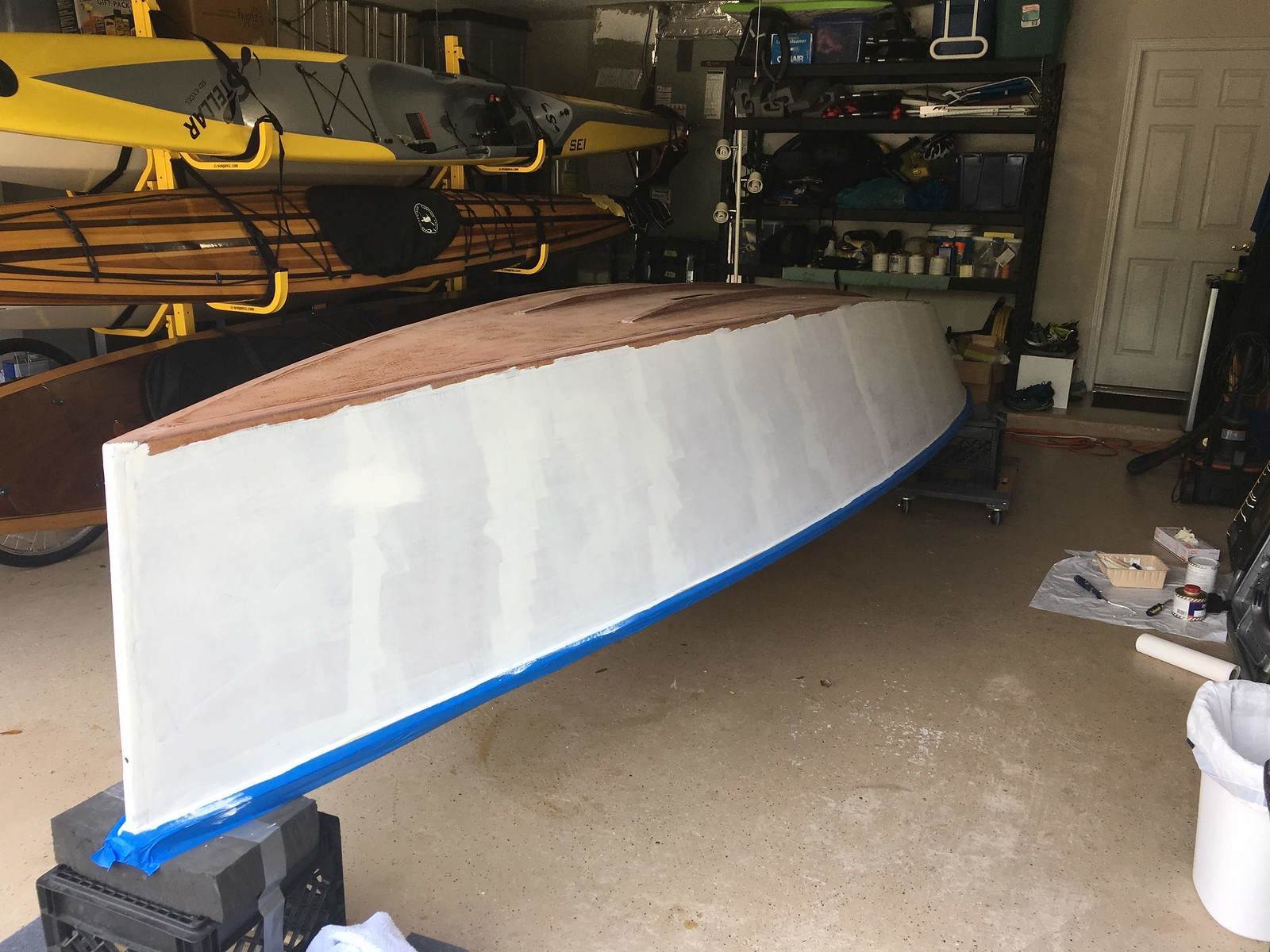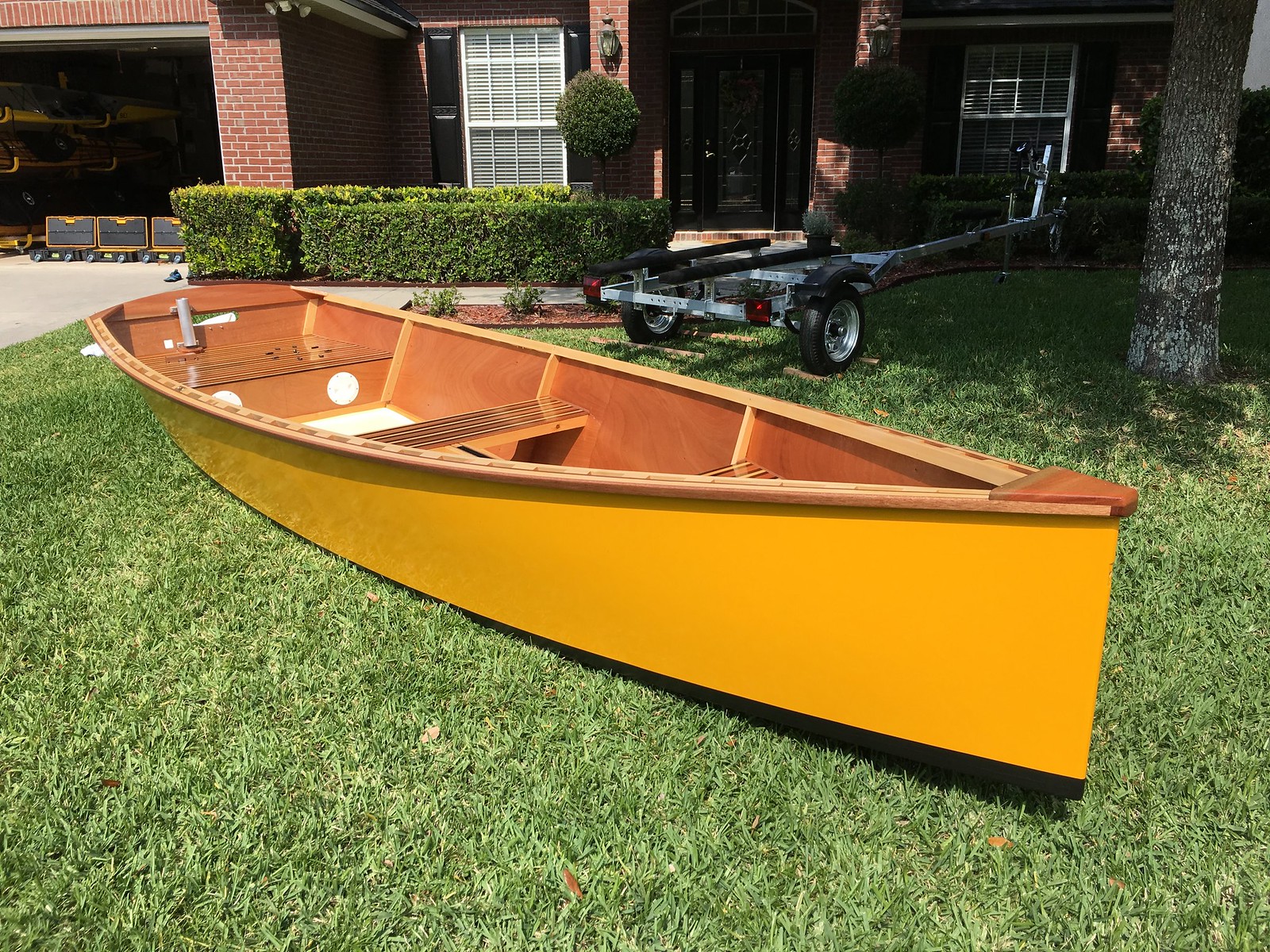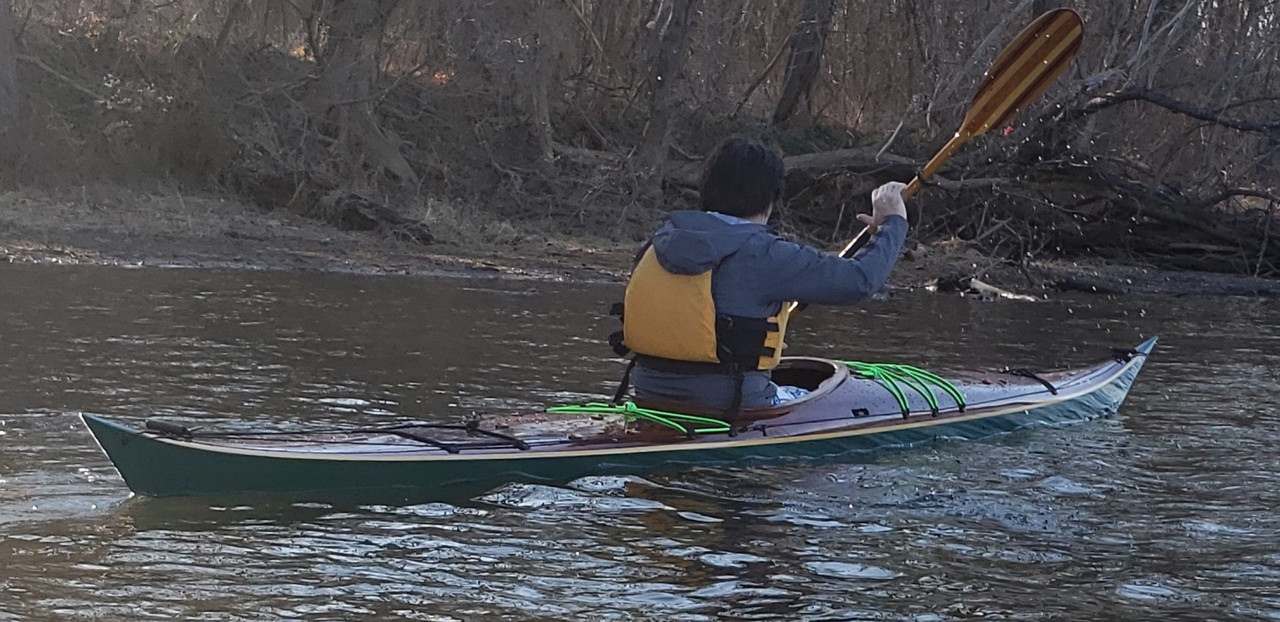Builders' Forum |
|
| ↓ Scroll to Last Comment ↓ | Forum Guidelines | Builders' Forum | |
Going to be building a Northeaster Dory. My question; Should Interlux primer be applied over epoxy if using Interlux Brightside paint?
Mark
13 replies:
RE: Interlux primer
So debating on this myself.
In a video by Bill Thomas on Off center harbor. He recommended not priming just painting with topcoat and filling irregularities with Bondo or marine acrylic putty between coats. So not sure which way to go???
The knock on high build primer is its ability to absorb moisture leaving a less than perfectly stable substrate for topcoat to adhere to. Plus the dusty sanding required, you CANNOT wet sand. No experience with either method so curious to hear other experienced opinions. 🤔
RE: Interlux primer
I have very mixed opinions on this subject.
As someone with a BS in Chemistry, I am strongly inclined to follow the manufacturer's directions and use primer even though many have successfully done without.
I used Intelux primer under Topsides on two kayaks and they came out well, but I HATED the primer part. It is thick nasty stuff that makes clouds of dust when you sand.
I used Epifanes primer under their Monoeurethane on my Goat and found that to be much easier to work with.
I know this probably does not help.


RE: Interlux primer
On the product description page for the primer it says, "should not be used below the waterline".
When you guys use the primer, do you actually follow that? And if so, how do you determine where the waterline is? :)
RE: Interlux primer
@ Andrew G
search here Pre Kote. A lot has to do with individual preferences and proper application procedures.
Still on a fence myself. PP
RE: Interlux primer
my 2 cents on the precoat primer quiestion -- skip it.
the interlux 1 part primer, if applied properly is almost 100% sanded off and only filling the smallest of depresions or pinholes. so if you are doing it right, you, in fact barely notice the difference of having it vs not having it. so i now just focus on and take the extra effort of a good saning on the raw epoxy.
the brite sides attaches well to the epoxy and is quite durable and i have a lot of experience with a lot of boats over a lot of miles and year to develop my perspective on that.
when i did use the primer, probably like a lot of folks, i was really not using it right and there was a lof of it still there. it forms a very weak substrate that is not compatible with water (hence why they say don't use below the waterline) and while the paint itself will protect it, if you scratch the paint and there is any primer exposed, the scratch now can become a scab as the primer sucks up water.
if i am having a smoothing problem, like not doing a good job filling the weave or a minor panel misalighnment or depression/unfarenesss, and i am going to paint it, i will make a microbaloon/epoxy pasted and trowel it over the hull and sand that. it is easy to sand and 100% water proof.
below are pictures of some painted boats....as good or better than anything i did with primer:
night heron hybrid with green painted hull...smoothed with microballoonsm presents.like glass:

a gaggle of older chesapeakes,,,,a 14 (yellow) and two 17LT (green and red). one of these was my first use of primer that ended up getting redone when the paint started to fail and the other two after having learned my lesson and just did a good sanding job. while not as refined as the night heron, no discernable difference in the finish quality primer/non primer.

h
.
RE: Interlux primer
@hspira
if i am having a smoothing problem, like not doing a good job filling the weave or a minor panel misalighnment or depression/unfarenesss, and i am going to paint it, i will make a microbaloon/epoxy pasted and trowel it over the hull and sand that. it is easy to sand and 100% water proof.
H, how do you know/see these issues before coating with paint. Yeah it looks smooth til it gets glossy then they all show. From my experience painting cars way back when.
auto body shops use a guide coat sort of the equivalent of what the primer coat would do.
So see my prior post in this thread on Bill Thomas method. Is that what you do??
Thanks for your help all, PP
RE: Interlux primer
Thanks for feedback. After doing a lot of reading I have come to these conclusions.
Interlux precoat absorbs water. If you apply it during humid weather it will not dry.
It also might be a problem for your finish below the waterline
Sanding it is terrible in that there is a lot of dust. Best done outdoors
It softens your overcoat paint. The primer is soft and thus the paint over it will chi[p much easier
Some comments I have read say that your paint finish will not be as bright unless you apply 4 or 5 coats
On the plus side it will fill the imperfections in your sanding job.
If using it you might want to sand it with a longboard this will leave the imperfections with primer and leave the smooth epoxy exposed
RE: Interlux primer
to answer PPs question - yes what i do is functionally equivelent to the bill thomas method...i am just making my own bondo.
on sorting out where you need this....i use a longboard and some light pencil marks and that will expose depressions that need to be built up. also i play with the lights and wet sections with denatured alcohol to see where imperfections are.
on mrosie's notes below that, my only exception with what you are summarizing is if you have a depression that was exposed by longboarding, you would not want to fill it with primer for all the reasons you identified prior to that point.....you want to fill and signfiicant depressions with bondo (epoxy/microballoons). pimer is only good for pin-holes and very small scale defects. so that is why when you use it correctly, almost all of it is sanded off.
h
RE: Interlux primer
@hspira
so I'm leaning toward taking your advice but just to clarify
you do all filling of imperfections prior to any topside paint
or in between coats
or both?
Having just spent a week purging my shop/garage of dust while suffering from Covid (probably not the smartest thing but I was bored to death) the last thing I want is more dust inside or outside.
thanks Happy new year
PP
RE: Interlux primer
i try to fill all imperfections before any paint goes on.
if you notice an imperfection after the paint goes on you can sand it back to the epoxy and readdress that particular area....but i don't find it too hard to get it right before paint if one has good light and carefully inspects the hull.
on dust, if not using my ROS that connects to my shop vac, i will i just tape the hose of my shop vac to my chest to pull the air/dust into the vac (the area closest to the work) before it gets all over the place.
h
RE: Interlux primer
Reading through this thread, I notice that nobody addressed Andrew's question regarding below waterline use.
Interlux Prekote and Brightsidesare designed for use above the waterline only. That means that they were not designed for continuous immersion. They work well on most of the CLC boats because small craft like kayaks and dories spend at max a few hours/days in the water and are stored dry. If there is a chance that your boat will spend longer than a couple of days continuously in the water, then a dedicated bottom paint would be better.
On my Goat, I decided to go with an airboat coating called Wetlander on the bottom. It not only eliminates the continuous immersion problem but it is also far more durable than regular paint. On the down side, it is way expensive.
Deciding where the waterline is can be a problem if it is not drawn on the plans. Even if marked, it is more advisory than anything because on small craft, the WL depends greatly on exact crew weight and placement. The WL was not marked on the GIS plans so I just followed the contour of the bottom a couple inches above the chine.


RE: Interlux primer
Yeah, thank you, Mark! So unless the boat stays in the water for prolonged period of times, Interlux Prekote is OK everywhere.
Even though this thread has almost comvinced me that it's more trouble than it's worth. :)













RE: Interlux primer
» Submitted by Silver Salt - Mon, 1/4/21 » 5:09 PM
It's not necessary, paint will bond perfectly well to epoxy. It's only to fill little irregularities and scratches.